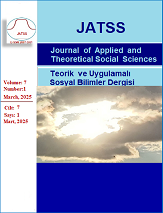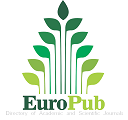A The Invasion of Patriarchal Ghost into Different Woman Representations: An Analysis of the Film, Motherland
Abstract
Introduction: This study attempts to read the phenomenon of gender through the film Motherland and examines three important figures of the patriarchal social order. The first of these is Halise as the carriers and implementers of the dominant ideology; the second is Emine, who is convinced of the illusion of male domination and cannot realize her feminine power; and the third is Nesrin, who tries to oppose all dominant patriarchal values. The aim of the study is to discuss the identities of women, which overlap in some places and completely separate in others, in a sociological context through three main characters.
Method: The film was analyzed in the context of women's intersectionality by reading the concepts of patriarchal bargaining, family institution and male domination through its three main characters. The scenes, symbols and dialogues in the film were addressed with a feminist analysis approach.
Results or Findings: The character of Anne Halise negotiates with the patriarchal ideology and shapes her relationship with her daughter Nesrin. Nesrin is in constant conflict with her mother as a character who opposes the values of the patriarchal ideology. Emine is represented as a figure who is made to feel absolute helplessness by the male power.
Discussion or Conclusion: The film Motherland gains importance in terms of understanding how the patriarchal ideology, which hovers around women like a ghost and organizes and disciplines everything according to its own norms, is reproduced through women.
Metrics
References
Adorno, T., & Horkheimer, M. (2011). Sosyolojik açılımlar. (M. S. Durgun., & A. Gümüş. Çev.). Bilgesu Yayınları.
Akbulut, H. (2020). Film festivalleri bağlamında Ana Yurdu Filminin çerçevelenişi: Bir Türkiye metaforu olarak Ana Yurdu, İlef Dergisi, 7(2), 217-246. https://doi.org/10.24955/ilef.822756 DOI: https://doi.org/10.24955/ilef.822756
Althusser, L. (1991). İdeoloji ve devletin ideolojik aygıtları. (Y. Alp., & M. Özışık. Çev.). İletişim Yayınları.
Badinter, E. (2011). Kadınlık mı? Annelik mi? (A. Ekmekci, Çev.). İletişim Yayınları.
Beauvoir, S. (1993). Kadın “ikinci cins” genç kızlık çağı. (B. Onaran, Çev.). Payel Yayınları.
Bora, A. (2010). Kadınların sınıfı: Ücretli ev emeği ve kadın öznelliğinin inşası. İletişim yayınları.
Bourdieu, P. (1997). Toplumbilim sorunları. (I. Ergüden, Çev.). Kesit Yayınları.
Bourdieu, P. (2006). Pratik nedenler: Eylem kuramı üzerine. (H. U. Tanrıöver, Çev.). Hil Yayınları.
Bourdieu, P. (2015). Eril tahakküm. (B. Yılmaz, Çev.). Bağlam Yayıncılık.
Carbado, D., Crenshaw, K.W., Mays, V. M., & Tomlinson, B. (2013). Intersectionality: Mapping the movements of a theory1. Du Bois review: Social Science Research on Race, 10(2), 303-312. DOI: https://doi.org/10.1017/S1742058X13000349
Diken, B., & Laustsen, C. B. (2011). Filmlerle sosyoloji. (S. Ertekin, Çev.). Metis Yayınları.
Direk, Z. (2015). Karşılıksız hayat. Cogito 81(1), 158-167.
Dowd, J.J. (1999). Waiting for Louis Prima: On the possibility of a sociology of film. Teaching Sociology, 2, 324-342. https://doi.org/10.2307/1319040 DOI: https://doi.org/10.2307/1319040
Kandiyoti, D. (2013). Cariyeler bacılar yurttaşlar kimlikler ve toplumsal dönüşümler. (A. Bora, F. Sayılan, Ş. Tekeli, H. Tapınç, F. Özbay, Çev.). Metis Yayınları.
Karaman, E.D., & Doğan, N. (2018). Annelik rolü üzerine: Kadının “annelik” kimliği üzerinden tahakküm altına alınması. Gümüşhane Üniversitesi İletişim Fakültesi Dergisi, 6(2), 1475-1496. https://doi.org/10.19145/e-gifder.443214 DOI: https://doi.org/10.19145/e-gifder.443214
Küçük, U. (2019). 2000 sonrası bağımsız Türk sinemasında hegemonya kavramı ve aile: Çoğunluk (2010), Tepenin Ardı (2012) ve Ana Yurdu (2015) filmlerinin sosyolojik analizi. [Yayınlanmamış Yüksek Lisans Tezi]. Kocaeli Üniversitesi.
Mulvey, L. (1993). Görsel haz ve anlatı sineması. (N. Abisel, Çev.). 25. Kare Sinema Dergisi, 3, 18-24.
Özkan, D. (2016). “Oblivion” filminde özne, iktidar ve özgürlük ilişkisi. Erciyes İletişim Dergisi, 4(4), 16-28. https://doi.org/10.17680/akademia.07803 DOI: https://doi.org/10.17680/akademia.07803
Sever, M. (2015). Kadınlık, annelik, gönüllü çocuksuzluk: Elisabeth Badinter’den kadınlık mı annelik mi? Tina Miller’dan annelik duygusu: Mitler ve deneyimler ve Corinne Maier’den no kid üzerinden bir karşılaştırmalı okuma çalışması. Fe Dergi, 7 (2), 71-86. https://doi.org/10.1501/Fe0001_0000000144 DOI: https://doi.org/10.1501/Fe0001_0000000144
Suárez, G. (2015, Eylül 10). Motherland: The traditional community and the modern individual come face to face. Cineuropa. https://cineuropa.org/en/newsdetail/298367/
Şerifsoy, S. (2013). Aile ve Kemalist modernizasyon projesi, 1928-1950. içinde. A. G. Altınay (Ed.), Vatan, Millet, Kadınlar (ss.167-200). İletişim Yayınları.
Umunç, C. (2022). Sinemada temsil, göstergebilim ve sembol: “PK” filmi örneği. İletişim Kuram ve Araştırma Dergisi, 2022(57), 88-111. https://doi.org/10.47998/ikad.1019865 DOI: https://doi.org/10.47998/ikad.1019865
Velioğlu Metin, Ö. (2019). “Annem izin vermese bu filmi çekmeyecektim”: Foucault’nun iktidar kavramı üzerinden Ana Yurdu filmi okuması. SineFilozofi, 4, 474-492. https://doi.org/10.31122/sinefilozofi.515242 DOI: https://doi.org/10.31122/sinefilozofi.515242
Wacquant, L. (2014). 1993’te Bourdieu: Bilimsel kutsamaya dair bir vaka incelemesi. Cogito, 76, 16-34.
Woolf, V. (2008). Kendine ait bir oda. (S. Öncü, Çev.). İletişim Yayınları.
Yerlikaya, B. (2020). 1980 sonrası Türk sineması’nda kadın temsilleri ve cinsiyetçi söylencenin reddi: Mine nasıl kurtulur?. Gaziantep University Journal of Social Sciences, 19(3). 1286-1303. https://doi.org/10.21547/jss.742998 DOI: https://doi.org/10.21547/jss.742998
Yılmaz Demirci, T. (2015). Osmanlı ve erken cumhuriyet dönemi Türkiye modernleşmesinde annelik kurguları (1840-1950). Cogito, 81(1), 66-90.






















